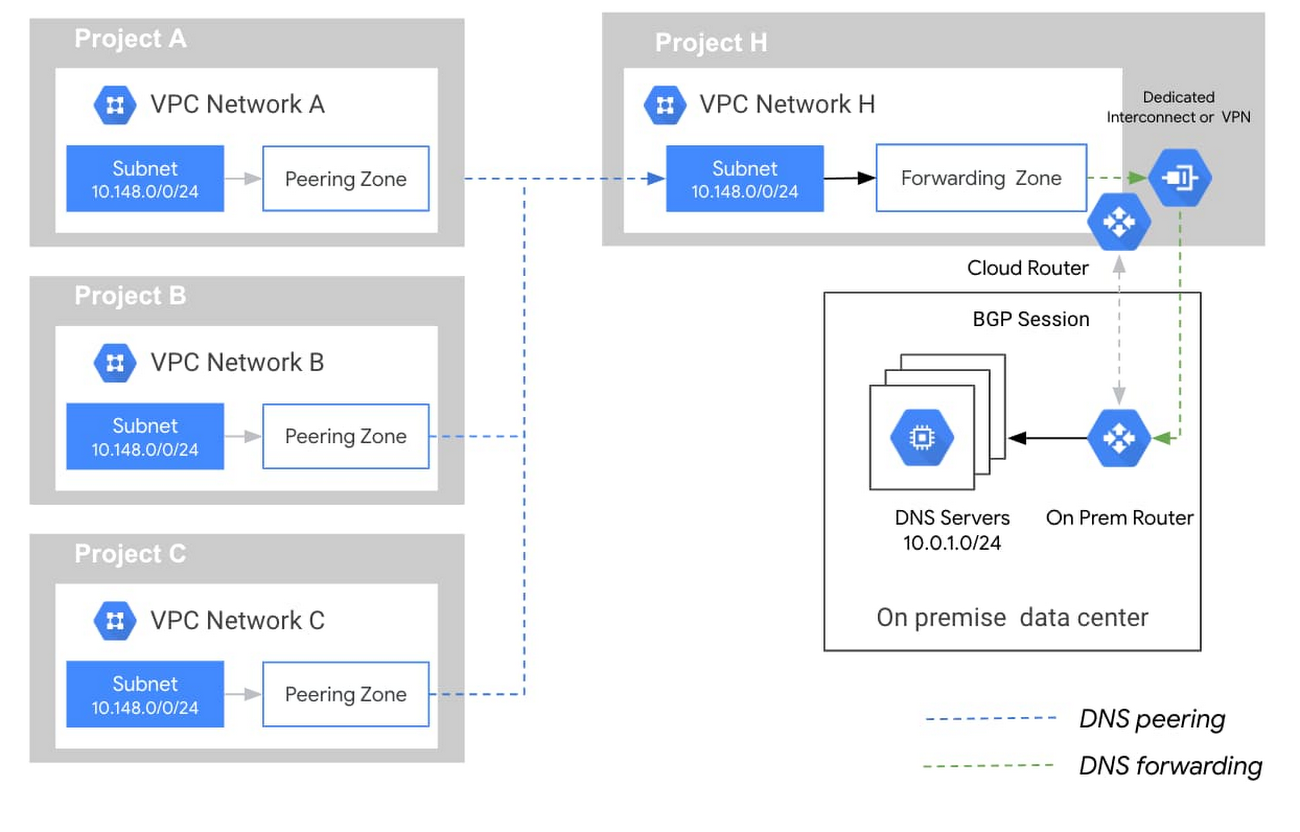Google Cloud DNS
- Cloud DNS is a high-performance, resilient, reliable, low-latency, global Domain Name System (DNS) service that publishes the domain names to the global DNS in a cost-effective way.
- Cloud DNS helps to publish the zones and records in DNS without the burden of managing your own DNS servers and software.
- Cloud DNS offers both public zones and private managed DNS zones.
- A public zone is visible to the public internet
- A private zone is visible only from one or more specified VPC networks
- Google Cloud also creates internal DNS names for VMs automatically, even if you do not use Cloud DNS
- With Shared VPC, Cloud DNS managed private zone, Cloud DNS peering zone, or Cloud DNS forwarding zone must be created in the host project
- Google Cloud offers inbound and outbound DNS forwarding for private zones
- Cloud DNS offers DNS forwarding zones and DNS server policies to allow lookups of DNS names between the on-premises and Google Cloud environment
DNS Server Policies
- DNS Server Policies can specify inbound DNS forwarding, outbound DNS forwarding, or both.
- Inbound server policy refers to a policy that permits inbound DNS forwarding i.e. On-premises to VPC
- Outbound server policy refers to one possible method for implementing outbound DNS forwarding.i.e. VPC to On-premises
- It is possible for a policy to be both an inbound server policy and an outbound server policy if it implements the features of both.
- DNS Server Policies is similar to DNS Forwarding zones, except that it applies to all the traffic and not a single specific domain
- DNS Outbound Policy disables internal DNS for the selected networks
DNS Forwarding Zones
- Cloud DNS forwarding zones help configure target name servers for specific private zones.
- Using a forwarding zone is one way to implement outbound DNS forwarding from the VPC network.
- A Cloud DNS forwarding zone is a special type of Cloud DNS private zone. Instead of creating records within the zone, you specify a set of forwarding targets.
- Each forwarding target is an IP address of a DNS server, located in the VPC network, or in an on-premises network connected to the VPC network by Cloud VPN or Cloud Interconnect.
- Cloud DNS caches responses for queries sent to Cloud DNS forwarding zones
- DNS forwarding does not work between two Google Cloud environments
DNS Peering
- DNS peering allows sending requests for records that come from one zone’s namespace to another VPC network for e.g., a SaaS provider can give a SaaS customer access to DNS records it manages.
- To provide DNS peering,
- Cloud DNS peering zone must be created and configured to perform DNS lookups in a VPC network where the records for that zone’s namespace are available.
- The VPC network where the DNS peering zone performs lookups is called the DNS producer network.
- To use DNS peering,
- A network must be authorized to use a peering zone.
- The VPC network authorized to use the peering zone is called the DNS consumer network.
- DNS peering and VPC Network Peering are different services. DNS peering can be used with VPC Network Peering, but VPC Network Peering is NOT required for DNS peering. VPC peering does not enable DNS peering and must be setup explicitly.

VPC Name Resolution Order
- Each VPC network provides DNS name resolution services to the VM instances that use it.
- When VMs use their metadata server 169.254.169.254 as their name server, Google Cloud searches for DNS records in the following order:
- If the VPC network has an outbound server policy, Google Cloud forwards all DNS queries to those alternative servers. The VPC name resolution order consists only of this step.
- If the VPC network does not have an outbound server policy:
- Google Cloud tries to find a private zone that matches as much of the requested record as possible (longest suffix matching).
- Searching records that you created in private zones.
- Querying the forwarding targets for forwarding zones.
- Querying the name resolution order of another VPC network by using peering zones.
- Searches the automatically created Compute Engine internal DNS records for the project.
- Queries publicly available zones
- Google Cloud tries to find a private zone that matches as much of the requested record as possible (longest suffix matching).
DNSSEC
- DNSSEC is a feature of DNS that authenticates responses to domain name lookups
- DNSSEC protects the domains from spoofing and cache poisoning attacks
- DNSSEC provides strong authentication for domain lookups, but it does not provide encryption
- Both the registrar and registry must support DNSSEC for the Top Level Domain (TLD) used
- For Enabling DNSSEC
- Enable DNSSEC on the domain. DNS zone for the domain must serve special DNSSEC records for public keys (DNSKEY), signatures (RRSIG), and non-existence (NSEC, or NSEC3 and NSEC3PARAM) to authenticate the zone’s contents.
- DS record must be added to the TLD at the registrar
- DNS resolver that validates signatures for DNSSEC-signed domains must be used
GCP Certification Exam Practice Questions
- Questions are collected from Internet and the answers are marked as per my knowledge and understanding (which might differ with yours).
- GCP services are updated everyday and both the answers and questions might be outdated soon, so research accordingly.
- GCP exam questions are not updated to keep up the pace with GCP updates, so even if the underlying feature has changed the question might not be updated
- Open to further feedback, discussion and correction.